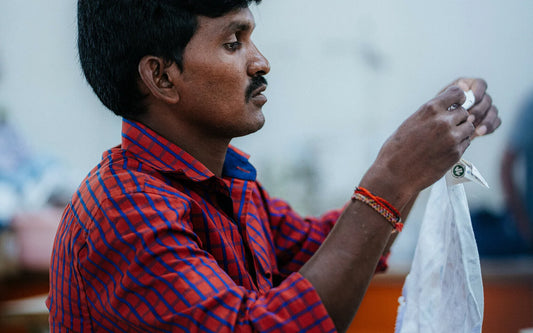Choosing the perfect yoga mat is not just a task, it's a personal journey that should be tailored to your unique practice and lifestyle. Your mat should be a reflection of you. Here are the essential criteria to consider when embarking on this personalized quest.
Adapt Your Mat To Your Practice
Meditation and Comfort :
For meditation enthusiasts, comfort is paramount. A thick, soft, plush mat is recommended to support the joints and enable you to sit comfortably for long periods. The extra padding also provides a cozy space for relaxation and yoga nidra practices.
Dynamic Yoga and Adherence :
For those who practice more dynamic yoga, such as Vinyasa, Ashtanga, or Hot Yoga, grip, size, and comfort are essential criteria. A mat with a good grip will prevent slips and accidents. At the same time, a moderate thickness will ensure a balance between comfort and stability. The dimensions of the mat must allow unrestricted freedom of movement, especially for extended postures. For example, in Vinyasa, where the practice involves flowing from one pose to another, a good grip and size are crucial.
Sweating and Safety :
Sweat is an important aspect to consider, especially if you practice intense forms of yoga. PVC mats can become slippery with heavy perspiration, increasing the risk of falls. Conversely, cotton or jute mats absorb perspiration better, offering a better grip. It's also a good idea to keep a small towel nearby to blot yourself regularly and avoid sweating too much on your mat.
Thickness and Portability :
The thickness of a yoga mat plays a crucial role not only in comfort but also in portability. 3 mm mats, often called "rugs," are ideal for travellers. They slip easily into a suitcase or bag, allowing you to practice yoga anywhere, and can also be used as outdoor mats for the beach or parks. On the other hand, 5 or 7mm mats offer greater comfort but are inevitably bulkier. It's worth noting that cotton mats are particularly practical to transport, as they can be rolled or folded to fit easily into bags.
"Choosing Materials and Embracing Ecology for a Healthier Planet".

Plastics problems:
Traditional PVC carpets pose ecological and health problems. PVC can contain endocrine disruptors, chemical substances that can interfere with the hormonal system. These chemicals can be released during practice, especially under the effect of heat and sweat, making vigilance on this point imperative. Practicing yoga involves deep breathing and constant contact with the mat, which is why it's so important to choose a mat free from harmful substances. As a short list of PVC harmful substances, we can mention :
- Phthalates: These chemicals make PVC flexible but can disrupt hormones, causing reproductive problems, respiratory issues, and potentially cancer.
- Volatile Organic Compounds (VOCs): PVC mats can emit VOCs, leading to headaches, dizziness, nausea, and long-term respiratory and central nervous system damage.
- Dioxins and Furans: Produced during PVC manufacturing and incineration, these toxic compounds are carcinogenic and can impair the immune and endocrine systems.
- Chlorine: PVC contains chlorine, which can release harmful chemicals affecting water quality and respiratory health..
Ecological alternatives :
Fortunately, eco-friendly alternatives do exist. Carpets made from natural materials such as natural rubber, cork, jute or organic cotton are becoming increasingly popular. Not only are these materials biodegradable, they are also free from toxic substances, guaranteeing a healthy, environmentally-friendly practice.
"Values and Aesthetics: Why Making Choices Based on Your Convictions Matters".
Yoga is more than just a physical activity; it's a philosophy of life that promotes well-being, harmony, and respect for oneself and nature. So, it's important to choose a yoga mat that reflects your personal values..
Ethical and authentic brands
Supporting brands that share your values can enrich your practice. Opt for transparent brands that emphasize ethics, sustainability and humanity in their manufacturing processes. Buying a yoga mat from these brands often means supporting fair trade and environmentally-friendly practices.
Aesthetics, Maintenance, and Durability
Remember, your yoga mat is not just a tool, it's a source of inspiration. A visually appealing mat can ignite your motivation and enhance your enjoyment of the practice. So, don't underestimate the power of aesthetics. However, it's also important to consider the practical aspects of maintenance and durability. Cotton carpets can be periodically washed and given a new anti-slip treatment to age gracefully while maintaining effectiveness. Cork carpets, on the other hand, can be more problematic in terms of aging or staining. They often require more care to maintain their appearance and functionality.
Choose a design that inspires you and brings you joy because this rug will be with you for years to come, perhaps taking pride of place in your living room or bedroom. A rug that's easy to care for and ages well will be a faithful companion in your practice.
Conclusion
Finding the ideal yoga mat is a personal quest that deserves a great deal of thought. It has to fit your practice, be made of safe, environmentally-friendly materials, and reflect your values and style. By taking these criteria into account, you'll find a mat that will enrich your yoga practice, while respecting your well-being and that of the planet.
Namaste.



